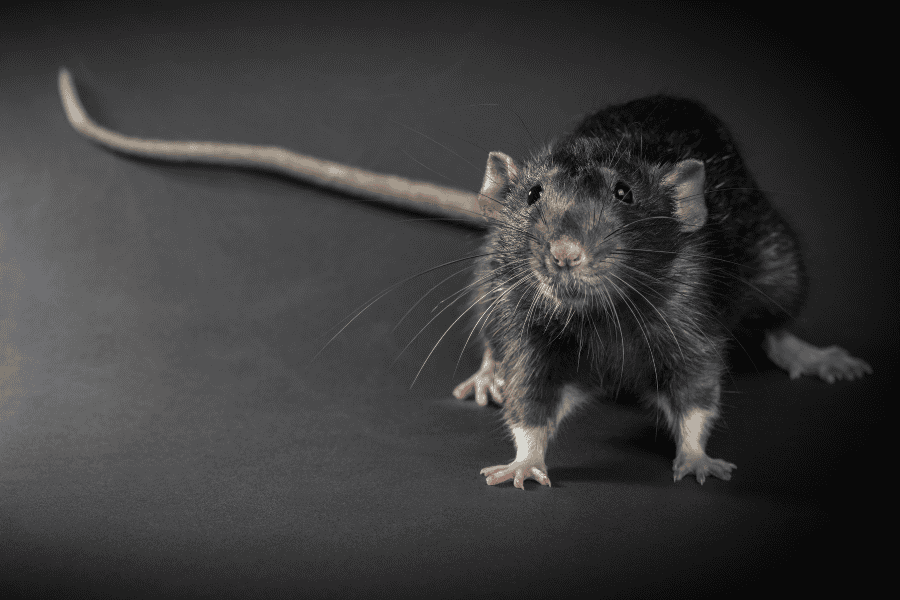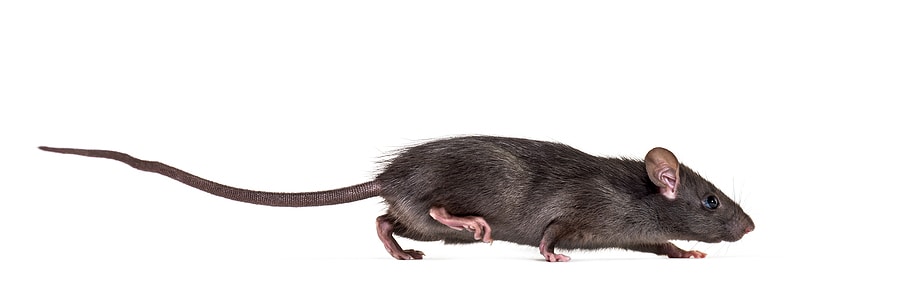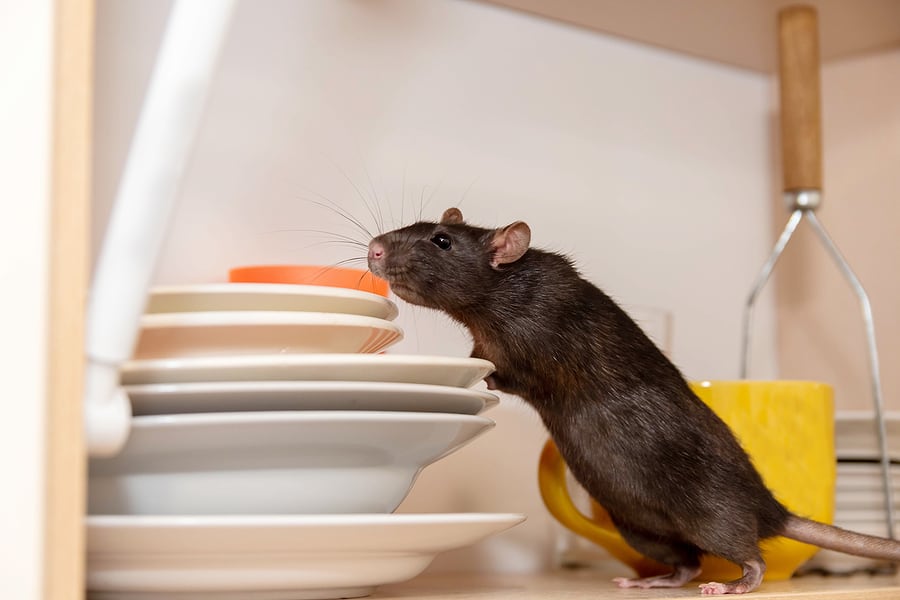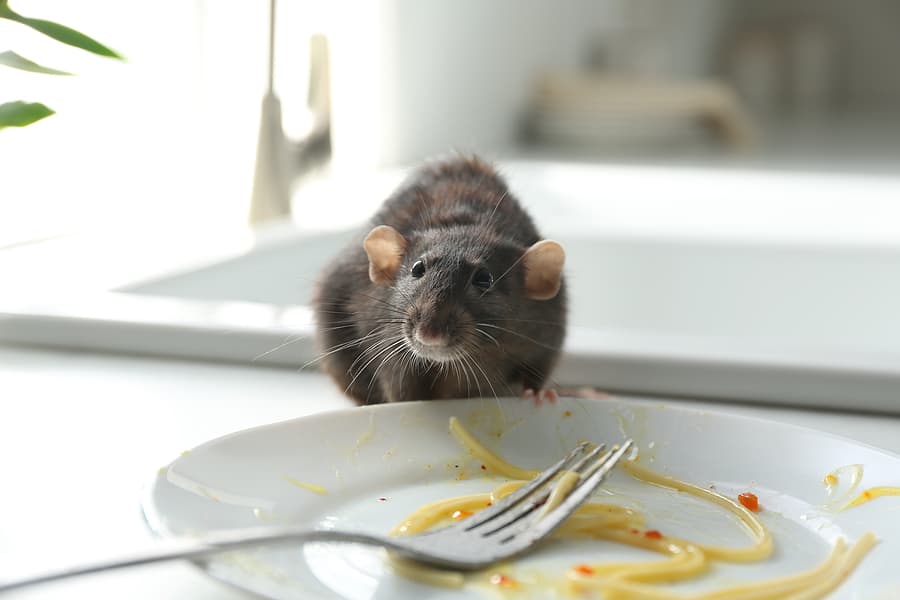READY TO GET STARTED?
REQUEST A FREE ESTIMATE
Fill out the form below or call (888) 466-7849 for a free, no-obligation estimate.

Roof rats, also known as black rats, are a common nuisance in Georgia homes and businesses. These rodents are notorious for invading attics, rooftops, and upper levels of buildings, causing damage and spreading diseases. Identifying a roof rat infestation early is crucial for preventing a growing rat population in your home. In this blog, we’ll discuss how to identify roof rats, where they are commonly found, why they are hazardous, and how to get rid of them. Plus, we’ll provide essential tips on rodent prevention.
Roof rats (Rattus rattus) are smaller and more agile than their relative, the Norway rat. Here are some key features to help you identify them:
Roof rats prefer to nest in high places, making them more likely to infest attics, rafters, and upper levels of homes and buildings. They are excellent climbers and often use tree branches, power lines, and vines to access rooftops. Some common nesting sites include:
Because roof rats are attracted to food sources, they often seek out accessible pet food, bird seed, fruits, and unsecured garbage bins.
Yes, roof rats pose several hazards to humans, pets, and property. Here’s why they should not be ignored:
Eliminating a roof rat infestation requires a combination of trapping, exclusion, and professional rat control services. Here are effective methods:
If the infestation persists, hiring a pest control company is the best solution. Professionals can assess the situation, set up strategic traps, and provide long-term rodent control solutions to keep roof rats out. If you are looking for eco-friendly options, green pest control is an alternative to traditional pest control methods that provide the same effectiveness with environmentally friendly solutions.
Preventing roof rats from invading your home is much easier than eliminating them after an infestation. Here are some tips to keep them away:
If you suspect a roof rat infestation in your Georgia home, it’s important to act fast. These rodents multiply quickly and can cause extensive damage. A professional pest control company can provide expert rodent control services, safely remove the infestation, and implement preventative measures to protect your home.
Don’t wait until the problem worsens—contact a pest control expert today to keep your home rat-free!

One of the most common rodents invading homes is the roof rat, also known as the palm rat, fruit rat, ship rat, and Alexandrian rat. Norway rats, which are stockier than roof rats, can also invade dwellings. If you want to get rid of the rats in your attic, you need to identify the species first. There are several key distinctions between roof rats and Norway rats. Let’s take a look at a few of the distinctions.
Roof rats are smaller than Norway rats (also known as the sewer rat or brown rat) and have longer tails. They can reach a maximum length of 18 inches (including the tail) and a minimum weight of 5 ounces.
Roof rats are commonly black in color, while Norway rats are brown or gray. Compared to Norway rats, roof rats are smaller, thinner, and their fur is smooth. Large, hairless ears and pointed faces are two other distinguishing characteristics of these rodents.
Roof rats, in contrast to other rat species, are adept climbers and construct their nests in elevated locations rather than underground burrows. They build their nests outside in places like trees, shrubs, wood piles, and dense vegetation. Whenever possible, these pests will seek out the warmest part of the house, which is typically the attic or another upper level. There are a number of places in the house where they might set up shop for the winter, including attics, cabinets, ceilings, garages, interior walls, bathrooms, outdoor kitchens, and pool decks.
Unlike many other rat species, roof rats eat a lot of nuts and seeds rather than meat scraps and other high-protein foods. Because of this, nuts and fruits make up the bulk of a their diet, though they are omnivores like all rats. If they’re hungry enough, they’ll eat almost anything, including vegetation, pet food, animal feed, vegetables, insects, nuts, seeds, tree bark, and even lizards.
Roof rats require water to survive and will often use the following as a water source: watering holes, leaky pipes, AC lines, pet water bowls, flowerpots, sprinklers, and gutters.
Because they are nocturnal and hunt for food at night, roof rats are not always visible. In order to detect an infestation, however, you must be familiar with the telltale signs of a problem. When located, the appropriate rodent prevention measures can be implemented.
The presence of roof rat feces is a clear indication of an infestation. Roof rat feces are less noticeable in size compared to those of Norway rats. The feces have sharp points and measure about half an inch in length. Other telltale signs of a roof rat infestation include:
Roof rats can be a real nuisance, and their droppings and urine can be dangerous to your health. Roof rats can get into your home by gnawing holes in the soffit or eaves. As soon as they get inside, they can do a lot of harm by wire-chewing, which can cause electrical problems and fires; nibbling up in the rafters of the loft; gnawing on water lines and causing leaks; and reducing insulation’s effectiveness by trampling on it. They can also contaminate your home with their urine and feces, causing health problems for you and your family.
Prevent roof rats with the following tips:
If you suspect you have a problem with roof rats or any other rodents, contact your local pest control company for a complete evaluation.
Common Rodents to Lookout for this Winter
14 Tips for Winter Pest Control
Are Spiders More Common In Winter?

Whether you find them in your attic, basement, crawlspace, or just near your property, spotting any rodents on your property is never ideal. These pests can cause significant property damage and pose health risks to you and your family. To avoid these sneaky creatures, it’s important for each homeowner to be aware of the different types of common rodents that will invade their Miami homes.
One of the largest species of rats, Norway rats measure from 13 to 18 inches in body length, are known to have thick fur, and are usually brown in color. These rats prefer to live closer to humans, searching for any food source available. They will eat any food type but usually prefer high-quality foods such as meat and fresh grains. Rats also need a water source to survive since they don’t get moisture needed from their food source and will look for any standing water.
Norway rats will burrow to make their nests underneath buildings, concrete slabs, around ponds, in garbage dumps, and more. In homes, they will typically look to areas that usually go undisturbed, such as crawlspaces or basements. These creatures will cause property damage, such as gnawing through plastic materials or lead pipes. Norway rats will bring fleas and mites into the home.
Only ranging from 5 to 7 inches in length, the house mouse has a fur coloration ranging from light brown to black with a tan or white belly. You can usually tell the difference between a house mouse and a rat by looking at their tails; mice tails are long, rough, and have little to no fur. House mice will eat any food to survive, but they usually like to feed on cereal grains. While rats need water to survive, house mice do not, as they get most of their water from the food they eat.
If these rodents find a food source, they typically stick around that area, establishing a territory 30 to 50 feet from it. House mice are incredible climbers, allowing them to jump and reach isolated or withdrawn areas. If they get inside the home, they can be a threat as they are known to create electrical fires by gnawing on wires.
Slightly smaller than a Norway rat, the roof rat measures around 13 inches in length, including the tail. These rodents are brown, black, or gray with a scaly, snaked tail which is longer than the head and body. They are excellent climbers and prefer to nest in high places within structures, including higher levels of homes, trees, and buildings. Roof rats prefer to eat fruit, vegetables, and cereal products. Roof rats eat a lot all at once and will return to that place time after time for food.
If you suspect any of these rodents inside your home, consider contacting your local Miami pest control company for a rodent control plan that will help remove, exclude, and prevent them in the future!

Dealing with a rodent is never an ideal situation for a homeowner. These creatures can pose serious health risks and property damage issues for your home and family. Different factors can attract varied species of rodents. To avoid these pests, every homeowner should be aware of the different types of rodents that can invade, along with how to prevent each one.
Norway Rats
Norway rats are one of the largest species of rats, measuring around 10 inches in body length. These rats have thick fur, usually brown with black shading. Norway rats are nocturnal and will often burrow into piles of garbage to search for food. If these creatures invade homes, it’s usually due to sparse food sources. They will typically invade areas in the house that go undisturbed such as crawlspaces or basements.
Norway rats can cause serious property damage by gnawing through materials like plastic and lead pipes. They can also bring house fleas and mites into homes. To prevent these rodents, make sure to tightly seal all trash cans outside your home. Check around the exterior and foundation of the home to search for any holes or gaps leading inside and seal them if needed.
Roof Rats
Roof rats are about 8 inches long with slender bodies. Their fur is smooth with gray coloring and black shading throughout. A great way to identify them is that their tails are darker than Norway rats and they are usually hairless and scaly. These rats are known to be extremely agile and skilled climbers. They live in colonies and prefer to nest in higher levels of buildings, trees, and homes. While they do prefer to eat fruit, they will still eat any available food source they can find.
If you happen to have fruit trees on your property, it’s important to clean up any fallen fruit as soon as possible as it will attract these creatures to your yard. Repair any roof damage such as broken tiles or gaps under eaves as these rats can sneak into any gap or hole that is as small as a quarter.
House Mouse
Light to gray in color, house mice weigh around 1 ounce or less! These small rodents like to nest in dark, secluded areas inside structures. House mice are excellent climbers and can jump up to a foot in height, which allows them to reach isolated or withdrawn areas.
House mice can be a threat to homes as they are known to spark electrical fires by gnawing on wires inside the house. They can also pose serious health threats as they can contaminate stored food and spread diseases such as salmonella. House mice often like to hide throughout household clutter. It’s essential to keep storage areas clean and well-organized and keep the boxes off the floor.
If you start to see signs of rodents in your home, contact a professional pest control company to ensure they don’t multiply and cause severe damage!